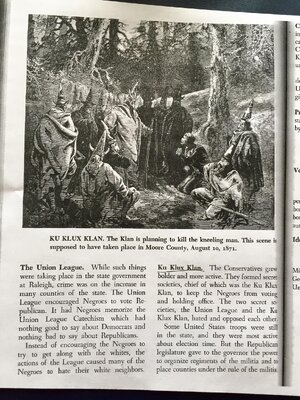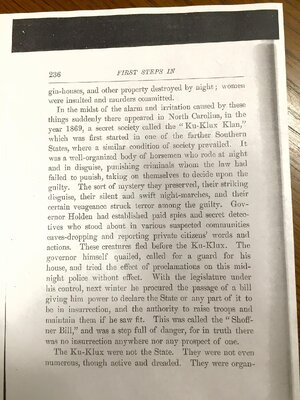donbosco
Inconceivable Member
- Messages
- 4,664
What we're talking about today...
"WHAT WE TOLD THE CHILDREN: TEXTBOOKS SINCE 1907"

Page 324 from the NC History textbook (North Carolina: History, Geography, and Government) that I was assigned in the 7th grade (1971). It was published in 1940 and 1959 (if revisions were made I cannot account for them). The authors were Hugh T. Lefler, Kenan Professor of History at UNC and Albert Ray Newsome, also of the Department of History at UNC.
"WHAT WE TOLD THE CHILDREN: TEXTBOOKS SINCE 1907"

Page 324 from the NC History textbook (North Carolina: History, Geography, and Government) that I was assigned in the 7th grade (1971). It was published in 1940 and 1959 (if revisions were made I cannot account for them). The authors were Hugh T. Lefler, Kenan Professor of History at UNC and Albert Ray Newsome, also of the Department of History at UNC.
“In the years after 1898, the state of North Carolina told the story of the white supremacy campaign to its children in a variety of ways. The earliest textbooks I have found, published in 1901, 1903 and 1906, ignored these events. The history text my son uses at his Chapel Hill middle school, North Carolina: A Proud State in Our Nation by W.S. Powell, is equally silent — though other contemporary textbooks mention the riot in detail. What follows is a sample of the state’s official history:
1907 — Young People’s History of North Carolina by Daniel Harvey Hill refers to the election of Daniel Russell, the Fusionist governor, and then notes that “in the second year of Governor Russell’s term, the Democrats elected a majority in the Legislature and the State returned in part to Democratic control.”
1916 — A Child’s History of North Carolina by W.C. Allen instructs that the Fusion legislature “put the city largely under negro rule. … The government of the city was badly carried on, and lawlessness prevailed.” The account says that blacks fired on whites, and whites returned the fire, killing several. “After the riot was over the incompetent negro and white officers of the city were forced to resign, one by one, and competent white men chosen in their places … a conservative board of aldermen [was] installed, negro policemen discharged ... Thus the revolution was at an end. Since that time Wilmington has greatly prospered.”
1933 — The Story of North Carolina by Alex Mathews with Walter Clinton Jackson teaches: “There were many Negro office-holders in the eastern part of the state, some of whom were poorly fitted for their tasks. This naturally aroused ill feeling between the races.”
1940 — North Carolina for Boys and Girls by Sarah William Ashe and Orina Kidd Garber (1940) says that under the Fusion government “negroes could hold office. The days of the Carpetbaggers seemed about to return. But the people of North Carolina remembered those terrible days too well to allow them to return.”
1958 — North Carolina History by Daniel Jay Whitener states: “Negroes who came to the rallies saw the ‘Red Shirts’ and silently slipped away. The Negro by nature was friendly and eager to avoid trouble … the Negroes were frightened and on election day many stayed at home. The careful planning and leadership of Simmons helped the Democrats. White supremacy was the issue. … A few days later a bad race riot took place in Wilmington. Negroes were killed and both Negroes and white men were wounded. Many Negroes fled from the town. The revolution of 1898 restored ‘white supremacy.’ ”
1978 — Carolina Quest by Thomas C. Parramore says: “Two days after the election a force of six hundred whites gathered at Wilmington and ushered in the new era by wrecking and burning the printing office … In the rioting that followed, ten blacks were reported killed and many others fled the city, including black city officials. A number of blacks were jailed for ‘starting a riot’ and a new white administration took over Wilmington’s government.”
1987 — North Carolina: The Story of a Special Kind of Place by William S. Powell reports: “In Wilmington, on the night of the election, armed white men appeared on the street. They were determined to end ‘Negro rule’ in the city promptly. On Nov. 9 and 10 there was a bloody riot in which ten or more blacks were killed, the office of Alex Manly’s black newspaper was burned, and many blacks fled. Republican rule in Wilmington came to an immediate end when Silas Wright, the black mayor, fled to New York. Three days later, the Raleigh News and Observer reported: ‘Negro rule is at an end in North Carolina forever.’ ”
2006 — North Carolina: the History of an American State by Kenneth Townsend teaches: “At no time did blacks ever enjoy representation equal to their numbers nor did ‘Negro rule’ ever exist in North Carolina. Nevertheless, the Democrats used the race issue to frighten voters and regain power. … Riding horses, wearing red shirts, and carrying guns … Democratic ruffians broke up Fusionist political rallies, disrupted black church meetings, whipped outspoken blacks, and drove blacks from the polls when they tried to register.”
~Timothy Tyson”
From “The Ghosts of 1898” in The News & Observer, November 17, 2006 (https://media2.newsobserver.com/content/media/2010/5/3/ghostsof1898.pdf)

Page 236 in First Steps in North Carolina History by Cornelia Phillips Spencer (aka "The Lady Who Rang The Bell"), published in 1888.
